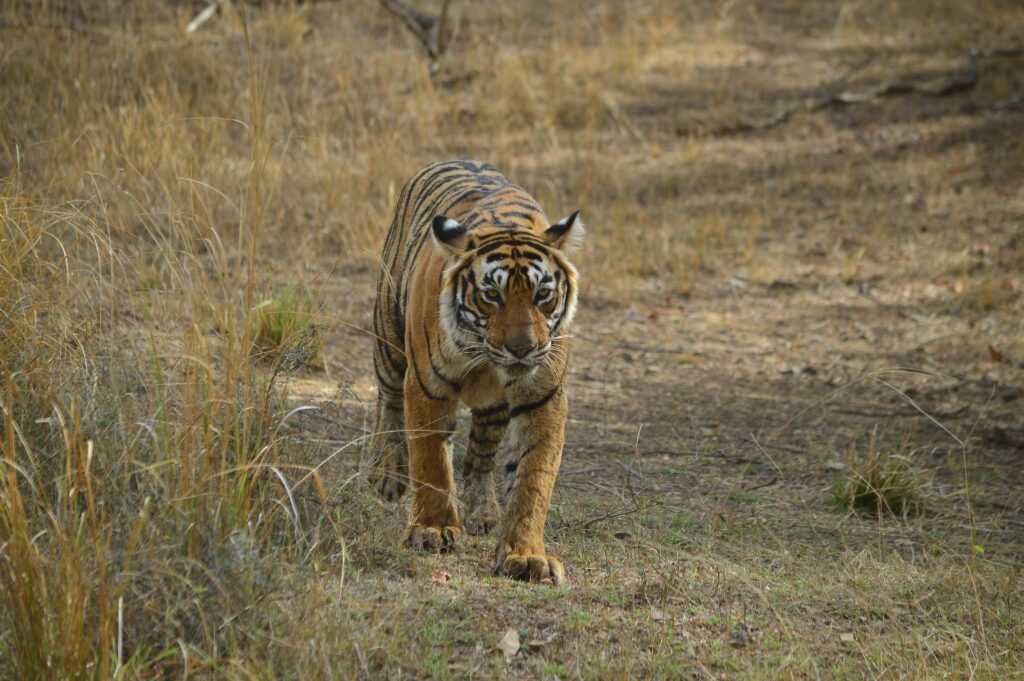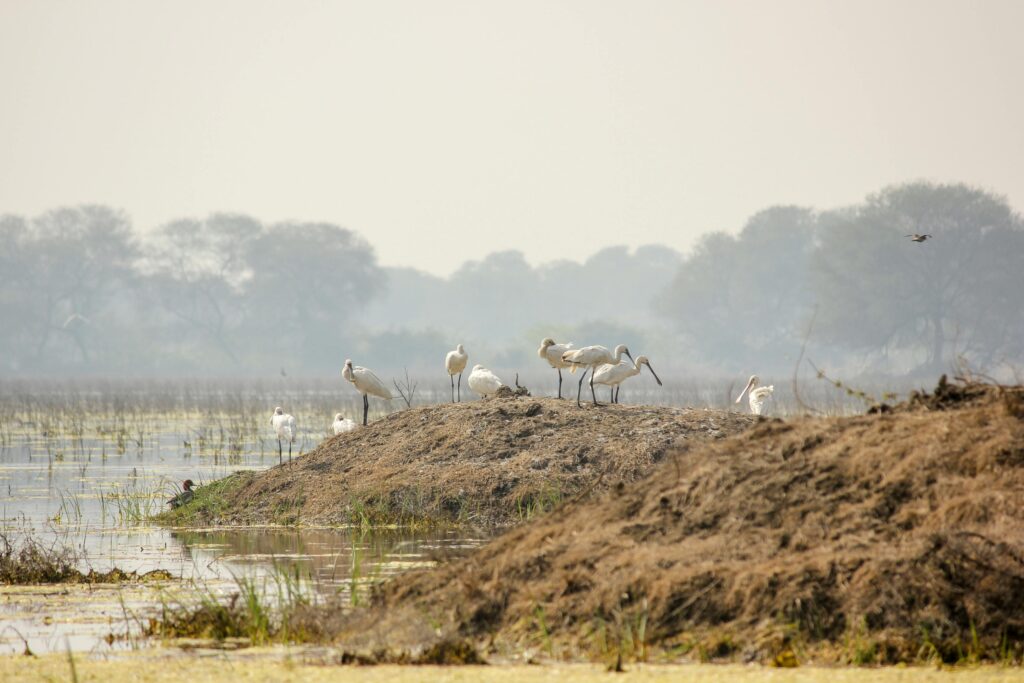Table of Contents
Introduction
When one thinks of Rajasthan, the mind invariably goes back to grand palaces, imposing forts, lively culture, and miles of the arid Thar Desert. But Rajasthan is also a land of regal heritage—it is a land that teems with productive biodiversity.
The Rajasthan Wildlife Sanctuaries are an important part of India’s ecological heritage.
Stretched over diversified landscapes, from dry deciduous forests and arid deserts to green hills of the Aravallis, these sanctuaries harbor some of India’s most unique flora and fauna.
The state boasts some of India’s most Famous Wildlife Sanctuaries and reserves.
These sanctuaries are not only important for conserving vulnerable species such as the Royal Bengal Tiger, the Great Indian Bustard, leopards, and migratory birds but also play a vital role in eco-tourism and cultural heritage.
Well known across the world, some of the National Parks of Rajasthan have earned international recognition. Places such as Ranthambore National Park and Keoladeo National Park attract wildlife lovers, birdwatchers, and conservationists from around the globe.
The options are staggering—from the jungles of Ranthambore that are home to the tiger to the bird lover’s heaven in Bharatpur, and from the golden sands of the Desert National Park to the fresh forests of Mount Abu, the experiences represent Rajasthan’s natural riches.
In this blog, we present 8 Popular Wildlife Sanctuaries of Rajasthan that are not only haven for birds and animals but also iconic Rajasthan National Parks which happen to be at the crossroads of nature, culture, and history.
Ranthambore National Park – The Land of Tigers
Location and Overview
Ranthambore National Park, one of Rajasthan’s crown jewels among the Wildlife Sanctuaries, is situated in Sawai Madhopur district.
Covering an area of approximately 1,334 square kilometers, this park is internationally known for its breeding population of Royal Bengal Tigers.
With its dramatic topography punctuated by lakes, dry deciduous forests, and rocky hills, it presents an unforgettable vision of the wild.
Historical Significance
While most wildlife sanctuaries are all about nature, Ranthambore is steeped in history. The 10th-century Ranthambore Fort, a UNESCO World Heritage Site, lies regally in the park.
Ancient temples, abandoned pavilions, and decaying walls speak of wars and dynasties alongside tigers, leopards, and sloth bears. This combination of history and wilderness makes it one of the Famous Wildlife Sanctuaries in India.
Wildlife Attractions

Royal Bengal Tigers: The park is one of the finest places in the globe to see tigers in the wild. All the tigers here have been well documented, and they are local celebrities.
Other Mammals: Leopards, caracals, hyenas, jackals, sambar deer, nilgai, chinkara, and langurs.
Birdlife: More than 320 species of birds, including painted storks, flamingos, and osprey that migrate to the area.
Landscape and Safari
Ranthambore’s terrain is rocky and picturesque, with dense forests complemented by grasslands. Rich ecosystems in the form of Padam Talao and Malik Talao lakes support the biodiversity of the park. Safari tours here offer not just hair-raising encounters with tigers but also stunning vistas.
Why Ranthambore Stands Out
Ranthambore is not just another tiger reserve; it represents the success of India’s conservation efforts. Its ability to balance cultural heritage with natural ecosystems makes it one of the most popular Rajasthan National Parks and a must-visit among the Wildlife Sanctuaries of Rajasthan.
Sariska Tiger Reserve – Blend of History and Wilderness
Introduction and Location
Situated amidst the Aravalli Hills, the Sariska Tiger Reserve in Alwar district in Rajasthan sprawls over almost 866 square kilometers. It is another jewel of the Wildlife Sanctuaries of Rajasthan. Famous for its rich wildlife and historical landmarks, Sariska is a tiger reserve as well as a cultural site.
Tiger Conservation
Sariska was the news in 2004 when its tiger population became locally extinct following poaching activities.
But in a historical conservation initiative, India translocated tigers from Ranthambore to Sariska in 2008. Now, the park boasts a re-emerging population of tigers, which is an indication of hope for wildlife conservation.
Wildlife Highlights
There are leopards, striped hyenas, caracals, jungle cats, wild boar, and langurs among the mammals.
Herbivores such as sambar deer, chital, nilgai, and wild pigs are the usual fare.

Birdwatchers can sight peafowls, sand grouse, treepies, and horned owls.
Cultural Heritage
Sariska stands out among Rajasthan National Parks in that it contains ancient temples and forts within its confines:
Kankwari Fort: Famous for serving as Dara Shikoh, brother of Mughal emperor Aurangzeb, prison.
Pandupol Hanuman Temple: Draws thousands of pilgrims and is located far into the reserve.
Why Sariska is Special
The integration of history, mythology, and wildlife lends Sariska a unique character. It is a model in itself for how Famous Wildlife Sanctuaries are both ecological paradises and cultural stores.
Keoladeo National Park (Bharatpur Bird Sanctuary) – Birdwatcher’s Paradise
Introduction
A World Heritage Site of UNESCO, Keoladeo National Park, also Bharatpur Bird Sanctuary, is a crown jewel among the Wildlife Sanctuaries of Rajasthan. Being different from tiger-based parks, this sanctuary is world-famous for its birdlife.
Avian Diversity
Keoladeo harbors more than 370 species of birds. During winter, it hosts a plethora of migratory birds who have traveled from as far as Siberia, Afghanistan, and Turkmenistan.

The Siberian Crane, which used to be a regular wintering visitor, brought fame to Bharatpur across the globe.
Other Wildlife
Though birds rule the sanctuary, mammals such as jackals, wild boars, and spotted deer also call the park home. Reptiles, amphibians, and fish contribute to the richness of the ecosystem.
Conservation Importance
First a duck-hunting preserve for the Maharajas, Keoladeo was proclaimed a protected sanctuary in 1971. It became UNESCO-recognised for its ecological values. Its wetland communities are essential to migratory birdlife and are part of India’s Ramsar Wetlands.
Tourist Experience
There are options available for tourists to explore the sanctuary on foot, bicycle, or cycle-rickshaws with local guides. The peaceful ambiance, along with the flurry of birds, makes it one of the most unusual Rajasthan National Parks.
Desert National Park – Thar’s Hidden Treasure
Introduction
Situated close to Jaisalmer, the Desert National Park is one of the most interesting Wildlife Sanctuaries of Rajasthan. Spread over an area of approximately 3,162 square kilometers, it is among the largest national parks in India.

In contrast to the dense forests of other sanctuaries, this park presents the distinctive ecosystem of the Thar Desert.
The Desert National Park is a picturesque desert of sand dunes, rocky outcrops and scrubby desert flora. Initially, it appears to be a barren landscape, but if explored closely, it is found to have unbelievable biodiversity in the arid environment. It has been found to contain fossils of 180 million years old, including dinosaurs.
Wildlife Highlights
Great Indian Bustard: One of the last remaining strongholds of this critically endangered bird, and also Rajasthan’s state bird.
Other Birds: Falcon, eagle, harrier, and kestrels migrate here in winter.
Mammals: Desert foxes, chinkaras, blackbucks, hedgehogs, and desert cats excel in the dry climate.
Reptiles: Spiny-tailed lizards and monitor lizards are frequently seen.
Ecological Importance
The Desert National Park emphasizes the way life copes with harsh climates. It is an important destination for study on desert ecology and conservation. It is one of the most renowned Wildlife Sanctuaries and attracts not only tourists but also scientists and wildlife photographers.
Mukundara Hills Tiger Reserve – Emerging Tiger Habitat
Overview
Mukundara Hills Tiger Reserve, which spans Kota, Bundi, and Jhalawar districts, encompasses approximately 759 square kilometers. Although comparatively new in contrast to Ranthambore and Sariska, it has immediately gained popularity as one of the significant Rajasthan National Parks.
History
Previously referred to as Darrah Wildlife Sanctuary, it was earlier a royal hunting ground. It was, in 2013, announced as a tiger reserve under India’s Project Tiger. With tiger translocation projects from Ranthambore, Mukundara Hills is being built up as an alternative habitat for tigers.
Wildlife
Predators: Tigers, leopards, hyenas, caracals, and wolves.
Herbivores: Chinkara, sambar, nilgai, and wild boar.
Birdlife: More than 300 species of birds, including eagles, vultures, and partridges.
Landscape
The Mukundara Hills range constitutes a natural ecosystem comprising dry deciduous forests, grasslands, and riverine communities. The Chambal River adds to the biodiversity of the area.
Significance
Mukundara is a success story in wildlife conservation in the making. Its restoration establishes the role of Wildlife Sanctuaries of Rajasthan in creating safe refuges for species at the brink of extinction and maintaining the ecological balance.
Mount Abu Wildlife Sanctuary – Oasis of Biodiversity
Introduction
In contrast to the deserts of Rajasthan, Mount Abu Wildlife Sanctuary is an entirely different experience. It lies in the Aravalli Hills and spans 288 square kilometers and is rated as one of the most picturesque Famous Wildlife Sanctuaries within the state.
Flora
Mount Abu is renowned for its verdant greenery, unlike the desert landscape of Rajasthan. The sanctuary has more than 800 species of flora, ranging from orchids and medicinal herbs to bamboo groves and evergreen forests at higher elevations.
Fauna
Carnivores: Striped hyenas, wolves, jungle cats, and leopards.
Herbivores: Sambars, langurs, porcupines, and wild boars.
Birds: Paradise flycatchers, peacocks, and green avadavat (a locally endemic and endangered bird).
Unique Features
Mount Abu’s temperate climate and diversity render it an ecological haven in Rajasthan. It offers habitats beyond those that can be achieved in the desert plains, hence one of the most unique Rajasthan National Parks.
Darrah National Park – A Historical Sanctuary
Location and Background
Darrah National Park, now consolidated with the Mukundara Hills Tiger Reserve, is of historical origin as a hunting ground of the royal family of Kota. Situated in southeastern Rajasthan, it lies over thick forests and river valleys.
Wildlife
Despite being lesser known than Ranthambore or Sariska, Darrah is home to a surprising diversity of wildlife:
- Mammals: The sanctuary shelters wolves, sloth bears, hyenas, wild boars, chinkaras, sambars, and nilgais. The presence of leopards adds to its charm as a predator’s habitat.
- Birdlife: Darrah also supports peacocks, partridges, quails, vultures, and migratory birds during the winter season.
- Reptiles: Monitor lizards, snakes, and turtles can be spotted in the wetlands and rocky outcrops.
The forests of Darrah are particularly important as a corridor for tigers, linking it with the Ranthambore and Mukundara landscape. This enhances the long-term survival of big cats in the region.
Cultural Significance
What makes Darrah unique among the Famous Wildlife Sanctuaries is its connection with Rajasthan’s royal past.
Visitors can still find remnants of old hunting lodges, fortifications, and routes once used by Mughal and Rajput armies.
This dual heritage of history and nature makes Darrah not just a wildlife reserve but also a living museum of Rajasthan’s layered past.
Current Importance
Being part of the Mukundara Hills Tiger Reserve, Darrah plays a critical role in expanding tiger habitats in Rajasthan.
With increasing human pressure and shrinking forests, tiger relocation and protection efforts here are crucial for the species’ future.
The park also preserves medicinal plants and rare herbs, making it valuable not only for wildlife but also for ecological sustainability.
Kumbhalgarh Wildlife Sanctuary – Together with the Great Wall of India
Introduction
Situated near the world-famous Kumbhalgarh Fort, a UNESCO World Heritage Site, the Kumbhalgarh Wildlife Sanctuary is among the most captivating Wildlife Sanctuaries of Rajasthan. Spanning 600 square kilometers, it has historical heritage along with natural wilderness.
Wildlife
Kumbhalgarh Wildlife Sanctuary boasts a wide range of animal life:
- Carnivores: Leopards are the top predators, accompanied by wolves, jackals, hyenas, and jungle cats.
- Herbivores: Chinkara, sambar, nilgai, four-horned antelope, and sloth bears roam freely.
- Birds: With more than 200 avian species, it is a paradise for birdwatchers. Grey junglefowl, white-breasted kingfishers, doves, and migratory birds are commonly sighted.
- Reptiles: Snakes, lizards, and tortoises add to the sanctuary’s diversity.
Notably, Kumbhalgarh was once considered for the Asiatic Lion Reintroduction Project, underlining its importance among the Rajasthan National Parks.
Trekking & Adventure
Kumbhalgarh is also well-known for eco-tourism activities. Horse safaris and trekking along the fort walls offer a mixture of adventure and wildlife discovery.
Why Kumbhalgarh is Unique
The proximity of the sanctuary to the ancient fort makes it an unusual place where history, culture, and ecology converge. It symbolizes the blending of human and natural heritage of Rajasthan.
Conclusion
The Wildlife Sanctuaries of Rajasthan are living testaments to how nature thrives even in the most extreme conditions.
Across the golden sands of the Thar Desert, the lush green valleys of the Aravallis, and the wetlands teeming with migratory birds, these sanctuaries embody resilience, diversity, and harmony.
They are more than reserves; they are natural kingdoms where the stories of survival and adaptation unfold every day.
What sets these Famous Wildlife Sanctuaries apart is their sheer variety. Few places in the world can boast such contrasting landscapes within a single state.
The tiger-dominated jungles of Ranthambore National Park stand in stark contrast to the arid expanses of the Desert National Park.
The bird-filled skies of Keoladeo Ghana National Park differ greatly from the serene forests of Mount Abu Wildlife Sanctuary.
Together, they weave a tapestry of ecosystems that make Rajasthan one of India’s most remarkable wildlife destinations.
The Rajasthan National Parks are also unique because they blend natural wonders with cultural heritage. Within these protected landscapes lie ancient temples, fort ruins, and sacred groves, reminding us that humans and wildlife have always shared these lands.
At Ranthambore, the fort walls stand as silent guardians of both history and wilderness, while at Kumbhalgarh, the “Great Wall of India” overlooks the forests below, where leopards and antelopes roam free.
Beyond their beauty, these sanctuaries serve a critical role in conservation. They protect endangered species like the Great Indian Bustard, green avadavat, caracals, and tigers, while also ensuring the survival of medicinal plants, migratory birds, and delicate desert ecosystems.
They act as learning grounds for researchers, safe havens for biodiversity, and sources of livelihood for local communities through eco-tourism.
The ecological significance of the Wildlife Sanctuaries of Rajasthan goes hand in hand with their role as tourist destinations.
Travelers from across the globe come to witness the power of a roaring tiger, the grace of a blackbuck, or the flight of a Siberian crane.
For some, it is an adventure; for others, it is a spiritual connection with the wild. Yet for all, it is a reminder that nature, in its raw form, is both fragile and magnificent.
In essence, these sanctuaries are the ecological heartbeat of Rajasthan. They ensure that future generations inherit not only the state’s forts, palaces, and deserts but also its thriving wilderness.
They prove that Rajasthan is not only the land of kings and warriors but also of eagles, leopards, and tigers—where culture and conservation walk hand in hand.
The Wildlife Sanctuaries of Rajasthan are therefore more than just tourist attractions. They are symbols of survival, guardians of biodiversity, and reflections of India’s timeless bond with nature.
To explore them is to journey into the soul of Rajasthan itself—majestic, resilient, and eternal.

Pingback: Ranthambore National Park: 7 Incredible Facts About This Wildlife Sanctuary - Padharodesh